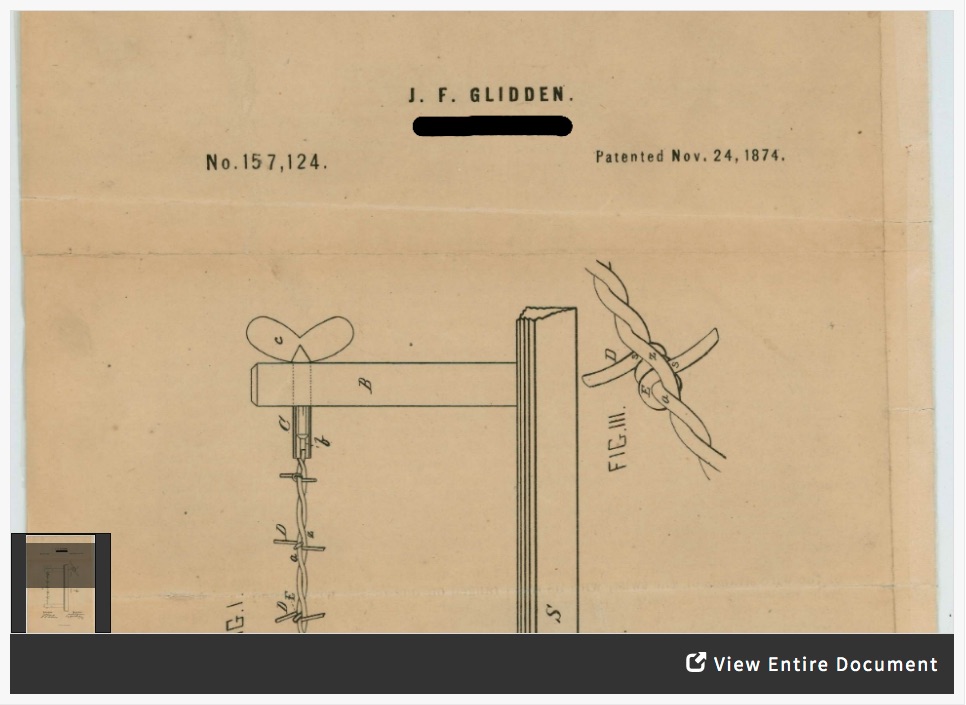In this activity, students will analyze Joseph Glidden's patent drawing for an improvement to wire-fences, more commonly known as barbed wire.
Suggested Teaching Instructions
This activity can be used during a unit on Westward Expansion, inventions and innovations, and/or to build document analysis skills in younger students. For grades grades 3-6. Approximate time needed is 15-20 minutes.
Ask students to look at the partially obscured patent drawing. Without providing any context, model document analysis:
- Quickly scan this document. What do you notice first?
- Describe the document and the invention it depicts as if you were explaining it to someone who can’t see it.
- Based on what you can see, what do you think is the purpose of this invention? List evidence from the document to explain your opinion.
After some discussion, reveal that this is a patent drawing for an important invention. If students are unaware of the definition of a patent, provide a brief definition that a patent gives an inventor a temporary monopoly on his or her invention. Explain how in the United States, the Constitution gave Congress the power to "To promote the progress of science and useful arts by securing for limited times to authors and inventors the exclusive right to their respective writings and discoveries" in Article I, Section 8.
Ask students to offer educated guesses as to the specific invention. If no one guesses barbed wire, provide the following clues from the inventor's description of the invention:
- "This invention has relation to means for preventing cattle from breaking through wire fences."
- "It consists in combining, with the twisted fence wires, a short transverse wire, coiled or bent at its central portion about one of the wire strand of the twist."
- "Should the spurs...become loose and easily movable...a few turns of the twisting-key will make them firm, besides straightening up the fence-wire."
Following a brief discussion and potential guesses, provide the following context for the invention. As you provide this information, ask if students can guess the invention.
Life in the American West was reshaped by a series of patents for a simple tool that helped ranchers tame the land. Before this invention, the lack of effective fencing limited the range of farming and ranching practices, and with it, the number of people who could settle in an area. Wooden fences and rocks for stone walls were costly and difficult to acquire on the plains and prairies of the American West. This invention was cheaper, easier, and quicker to use than any of these other alternatives.
Without fencing, livestock grazed freely, competing for food and water. Where working farms existed, most property was unfenced and open to foraging cattle and sheep. Once a year, cattle owners, unhindered by fenced property lines, led their herds on long cattle drives.
As the use of this invention increased, wide open spaces became less wide, less open, and less spacious, and the days of the free roaming cowboy were numbered. Land and water once open to all was fenced off by ranchers and homesteaders with predictable results. The appearance of this invention meant the end of both the open range and the freedom of the rancher and cowboy.
Living patterns of nomadic Native Americans were radically altered as well. Further squeezed from lands they had always used, some began calling barbed wire "the Devil's rope."
Following several other inventors, Joseph F. Glidden, an Illinois farmer, submitted this patent for improvement to wire fences, now commonly known as barbed wire. Glidden's invention made barbed wire more effective not only because he described a method for locking the barbs in place, but also because he developed the machinery to mass-produce the wire. Today, it remains the most familiar style of barbed wire and is used in a variety of different ways.
After sharing the historical context, ask students to brainstorm how barbed wire has been used in other ways in history and today.





